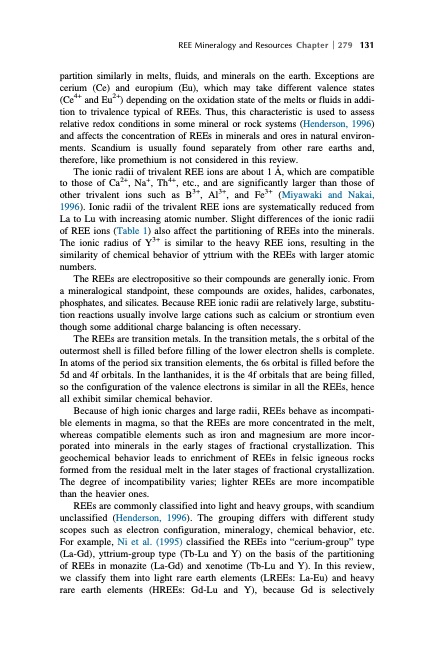
PDF Publication Title:
Text from PDF Page: 167
REE Mineralogy and Resources Chapter 279 131 partition similarly in melts, fluids, and minerals on the earth. Exceptions are cerium (Ce) and europium (Eu), which may take different valence states (Ce4+ and Eu2+) depending on the oxidation state of the melts or fluids in addi- tion to trivalence typical of REEs. Thus, this characteristic is used to assess relative redox conditions in some mineral or rock systems (Henderson, 1996) and affects the concentration of REEs in minerals and ores in natural environ- ments. Scandium is usually found separately from other rare earths and, therefore, like promethium is not considered in this review. The ionic radii of trivalent REE ions are about 1 A ̊ , which are compatible to those of Ca2+, Na+, Th4+, etc., and are significantly larger than those of other trivalent ions such as B3+, Al3+, and Fe3+ (Miyawaki and Nakai, 1996). Ionic radii of the trivalent REE ions are systematically reduced from La to Lu with increasing atomic number. Slight differences of the ionic radii of REE ions (Table 1) also affect the partitioning of REEs into the minerals. The ionic radius of Y3+ is similar to the heavy REE ions, resulting in the similarity of chemical behavior of yttrium with the REEs with larger atomic numbers. The REEs are electropositive so their compounds are generally ionic. From a mineralogical standpoint, these compounds are oxides, halides, carbonates, phosphates, and silicates. Because REE ionic radii are relatively large, substitu- tion reactions usually involve large cations such as calcium or strontium even though some additional charge balancing is often necessary. The REEs are transition metals. In the transition metals, the s orbital of the outermost shell is filled before filling of the lower electron shells is complete. In atoms of the period six transition elements, the 6s orbital is filled before the 5d and 4f orbitals. In the lanthanides, it is the 4f orbitals that are being filled, so the configuration of the valence electrons is similar in all the REEs, hence all exhibit similar chemical behavior. Because of high ionic charges and large radii, REEs behave as incompati- ble elements in magma, so that the REEs are more concentrated in the melt, whereas compatible elements such as iron and magnesium are more incor- porated into minerals in the early stages of fractional crystallization. This geochemical behavior leads to enrichment of REEs in felsic igneous rocks formed from the residual melt in the later stages of fractional crystallization. The degree of incompatibility varies; lighter REEs are more incompatible than the heavier ones. REEs are commonly classified into light and heavy groups, with scandium unclassified (Henderson, 1996). The grouping differs with different study scopes such as electron configuration, mineralogy, chemical behavior, etc. For example, Ni et al. (1995) classified the REEs into “cerium-group” type (La-Gd), yttrium-group type (Tb-Lu and Y) on the basis of the partitioning of REEs in monazite (La-Gd) and xenotime (Tb-Lu and Y). In this review, we classify them into light rare earth elements (LREEs: La-Eu) and heavy rare earth elements (HREEs: Gd-Lu and Y), because Gd is selectivelyPDF Image | HANDBOOK ON THE PHYSICS AND CHEMISTRY OF RARE EARTHS

PDF Search Title:
HANDBOOK ON THE PHYSICS AND CHEMISTRY OF RARE EARTHSOriginal File Name Searched:
Chemistry-Rare-Earths-49.pdfDIY PDF Search: Google It | Yahoo | Bing
Sulfur Deposition on Carbon Nanofibers using Supercritical CO2 Sulfur Deposition on Carbon Nanofibers using Supercritical CO2. Gamma sulfur also known as mother of pearl sulfur and nacreous sulfur... More Info
CO2 Organic Rankine Cycle Experimenter Platform The supercritical CO2 phase change system is both a heat pump and organic rankine cycle which can be used for those purposes and as a supercritical extractor for advanced subcritical and supercritical extraction technology. Uses include producing nanoparticles, precious metal CO2 extraction, lithium battery recycling, and other applications... More Info
| CONTACT TEL: 608-238-6001 Email: greg@infinityturbine.com | RSS | AMP |